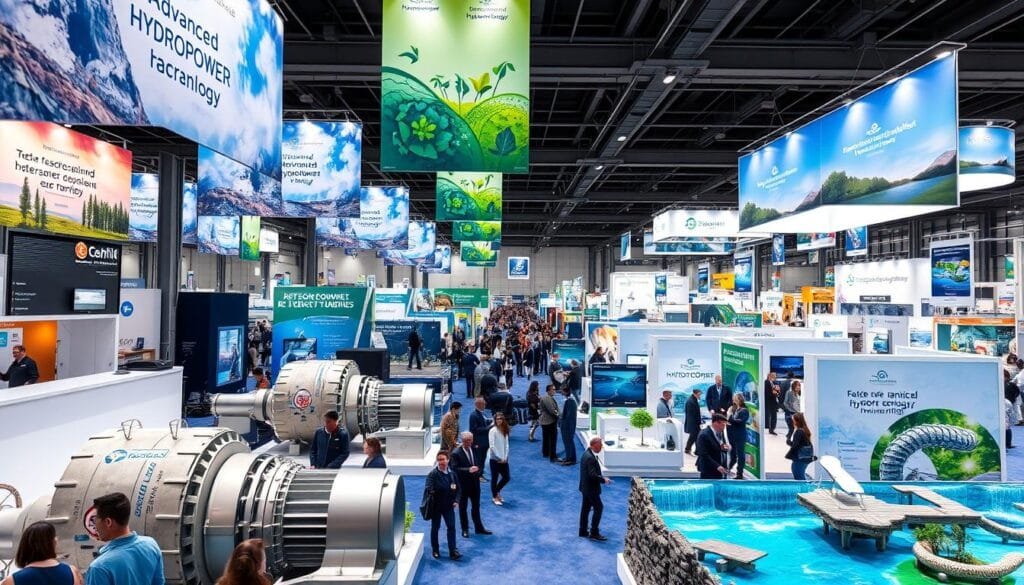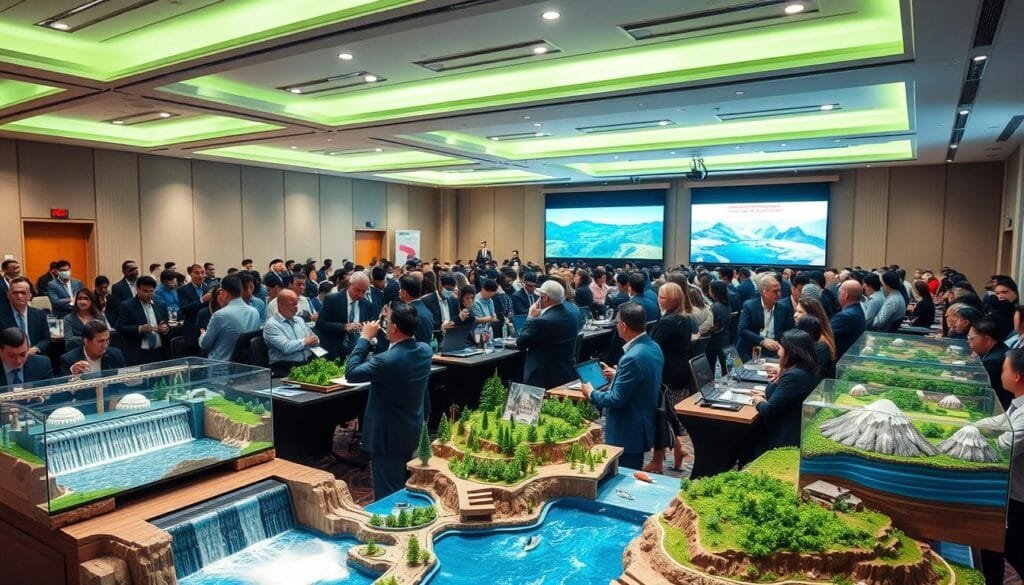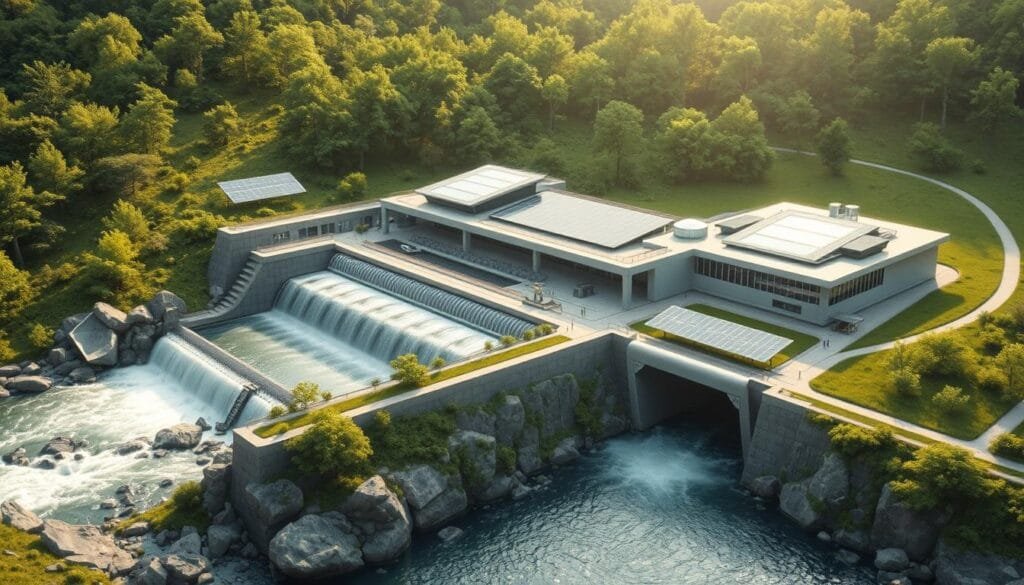HydroVision International is the top event for hydroelectric power worldwide. It brings together over 3,000 experts from more than fifty countries. This conference is key for renewable energy, highlighting hydropower’s role in sustainable energy.
The event is a must-attend for hydropower experts. It features over 300 companies and nearly ten networking events. People from utilities, engineering, and tech come to see the latest in renewable energy.
HydroVision International is a place for sharing knowledge. It has over sixty sessions on hydroelectric power’s biggest topics. It covers new tech and environmental issues, showing the future of the hydro industry.
Key Takeaways
- World’s largest hydro industry event attracting global professionals
- Over 300 companies representing fifty countries participate
- Comprehensive conference program with sixty specialized sessions
- Critical networking platform for renewable energy experts
- Showcasing latest innovations in hydroelectric power technology
Overview of HydroVision International Conference
HydroVision International is a key event for hydropower experts. It brings together over 3,000 professionals from more than 50 countries each year. This conference is a major event for water management and sustainable development in the hydroelectric field.
History and Evolution of the Conference
HydroVision started small but grew into a global leader in hydropower innovation. It has kept up with new technologies and challenges, making it a place for sharing knowledge.
- Launched as a regional event
- Expanded to international participation
- Grew from 100 attendees to over 3,000
- Developed detailed technical sessions
Global Impact on Hydropower Industry
The conference is key for sustainable development in hydroelectric power. It features over 300 exhibitors and 60 specialized sessions. HydroVision offers unique chances for professionals to see the latest in technology and strategies.
“HydroVision represents the future of global water resource management and renewable energy innovation.”
Conference Objectives and Mission
HydroVision International aims to improve hydropower tech, support green practices, and spark important talks on water management. It brings together utilities, engineers, and tech providers to speed up progress and teamwork.
- Promote technological innovation
- Foster international collaborations
- Support sustainable energy solutions
- Facilitate knowledge transfer
Conference Location and Dates for 2024-2025
HydroVision International brings together experts in hydroelectric power. They hold conferences in two key U.S. cities. These events offer great chances for professionals to meet, learn, and grow in the field.
The 2024 HydroVision will be in Denver, Colorado, on July 16, 2024. Denver is perfect for discussing new hydroelectric power ideas. Its strong energy scene and access to water make it a great place for this meeting.
In 2025, the event will be in Charlotte, North Carolina, from July 17-18. Charlotte is growing in the energy field. It’s a great place to talk about future hydroelectric power plans and tech.
“These conferences represent key moments for global hydroelectric power collaboration and knowledge sharing.” – HydroVision International Leadership
Key Conference Details
| Year | Location | Dates | Focus Areas |
|---|---|---|---|
| 2024 | Denver, Colorado | July 16, 2024 | Technological Innovation |
| 2025 | Charlotte, North Carolina | July 17-18, 2025 | Sustainable Hydropower |
- Networking with industry leaders
- Technical sessions
- Insights into new hydroelectric power trends
- Site visits to local hydropower plants
Attendees will find detailed programs to improve their hydroelectric power skills. They’ll also make important connections in these two unique locations.
Key Industry Stakeholders and Participants
HydroVision International is a place where many professionals work together. They focus on making hydropower technology better. The event is key for sharing knowledge and building connections in the hydroelectric power world.
Many important groups come to the event. Each group has a special role in improving river planning and green energy.
Power Producers and Utilities
Power producers are the heart of hydroelectric systems. They are key in making sure we have electricity. They work on new energy ideas, connecting the grid, and keeping our power on.
Consultants and Engineers
Experts in hydropower share their knowledge at the conference. They help with planning rivers, checking environmental effects, and designing better systems.
Technology Providers and Innovators
Companies with new tech show off their latest at the event. Their work is vital for better energy systems. They tackle big issues like making turbines more efficient, smart grid tech, and digital power management.
“The future of hydropower depends on collaborative innovation and strategic stakeholder engagement.” – U.S. Department of Energy Hydropower Vision Report
Hydro Vision Exhibition Showcase

The HydroVision International Exhibition Showcase is a key event for improving hydropower technology worldwide. It brings together top experts and innovators in the hydroelectric power field. They show off the latest solutions and technological advancements.
Visitors can see many new ideas changing the hydropower industry. The show focuses on important updates in sustainable energy, like new technologies that are better for the environment and more efficient.
Exhibition Highlights
- Advanced turbine design innovations
- Environmental monitoring tools
- Dam safety equipment
- Smart control systems for hydroelectric power generation
The showcase is also a great place for networking. It lets people meet with tech providers and industry leaders. Hydropower technology experts from all over share knowledge, make partnerships, and look for new projects.
| Exhibition Category | Number of Exhibitors | Countries Represented |
|---|---|---|
| Hydroelectric Power Equipment | 67 | 14 |
| Environmental Solutions | 42 | 9 |
| Control Systems | 48 | 11 |
“The HydroVision Exhibition is where innovation meets opportunity in the renewable energy sector.” – Energy Technology Review
Attendees will get to see the newest in hydroelectric power tech. It’s a chance to learn about the future of green energy.
Networking Opportunities and Professional Development
HydroVision International 2025 is a top spot for networking in the hydroelectric power field. It offers many chances to share knowledge and grow your career. You’ll find a variety of ways to connect and learn.
At the event, you’ll find many ways to boost your career and work with others. With over 2,000 people from 27 countries, it’s a global meeting place for water management experts.
Roundtable Discussions
Roundtable discussions are perfect for deep talks on big hydroelectric power issues. You can:
- Talk directly with top industry leaders
- Share new ideas in water management
- Discover the latest tech solutions
- Work on solving workforce problems
Industry Expert Meetings
Expert meetings are great for focused talks with the best in the field. They help create new partnerships and share knowledge.
| Meeting Type | Duration | Participants |
|---|---|---|
| Technical Sessions | 90-240 minutes | 20-50 professionals |
| Career Development | 45-120 minutes | 25-75 attendees |
| Specialized Meetups | 45 minutes | 10-30 participants |
Career Development Sessions
Career growth is a big focus. With 25% of the US hydropower team nearing retirement, these sessions help with skills transfer and career plans.
“Networking is not just about connecting with people. It’s about connecting people with opportunities.” – Industry Expert
Attendees can use tech to make lasting connections. This goes beyond just meeting people at the conference.
Sustainable Hydropower Development Track

The Sustainable Hydropower Development Track at HydroVision International Conference is key for the hydropower industry. It focuses on balancing energy needs with protecting the environment. This track is all about finding new ways to make hydropower both powerful and green.
“Our goal is to transform hydropower into a truly sustainable energy solution that respects both human and environmental needs.”
Key focus areas of the track include:
- Climate resilience strategies
- Ecosystem preservation techniques
- Innovative hydropower design principles
- Greenhouse gas emission measurement
The 2023 Roadmap Survey gave us important insights. It showed that making hydropower more climate-friendly is a top priority. About 90 people from the hydropower world took part in the survey. This shows we’re all working together to make things better.
| Sustainable Development Goal | Average Impact Ranking |
|---|---|
| Climate Resilience | High |
| Ecosystem Conservation | Medium-High |
| Greenhouse Gas Monitoring | Medium |
The conference track is all about finding ways to make things cheaper and better. Hydropower is a big part of U.S. energy, so making it sustainable is key. This way, we can keep our energy needs met while protecting the planet.
Environmental groups, government agencies, and tribal leaders play a big role. They help make sure we plan for the future in a way that works for everyone.
Environmental Impact Assessment Sessions
The HydroVision conference highlights key strategies for environmental impact in hydropower. These assessments are vital for understanding and reducing ecological risks in river basin planning.
Water Resource Management Strategies
Experts at the conference discuss ways to manage water resources. They aim to balance energy needs with protecting the environment. Key areas include:
- Comprehensive water quality monitoring
- Sediment management techniques
- Equitable water allocation strategies
“Sustainable hydropower requires a holistic approach to environmental impact assessment and water resource management.”
Ecological Conservation Techniques
The sessions focus on protecting biodiversity and ecosystem services. Participants learn about new methods for:
- Protecting fish populations
- Preserving habitat integrity
- Minimizing ecological disruption
Manitoba Hydro’s environmental protection program is a great example. It shows a comprehensive approach to environmental management. They review their environmental goals yearly and are certified under ISO 14001.
Regulatory Compliance and Best Practices
The sessions stress the need to meet international standards. They focus on developing environmentally friendly hydropower projects. Participants learn about the latest methods for environmental studies that support sustainable energy.
Technical Innovation and Technology Updates

The HydroVision International Conference highlighted major advancements in hydropower technology. It showed the industry’s dedication to renewable energy. Presentations focused on better turbine efficiency and how to better connect to the grid.
Some of the key tech developments in hydropower include:
- Advanced digital monitoring systems
- AI-powered predictive maintenance tools
- Innovative materials for dam construction
- Enhanced small-scale hydropower solutions
Researchers shared exciting new insights into renewable energy. Digitalization and machine learning are changing how hydropower works. They make power generation more precise and efficient.
The future of hydropower lies in smart, adaptive technologies that maximize efficiency and minimize environmental impact.
Research focused on several important areas of hydropower technology:
| Technology Area | Key Innovations | Potential Impact |
|---|---|---|
| Turbine Design | Advanced blade geometry | 15-20% increased efficiency |
| Remote Monitoring | AI-driven predictive systems | Reduced maintenance costs |
| Pumped Storage | Grid stabilization technologies | Enhanced renewable energy integration |
The conference showed how important innovation is for renewable energy. Hydropower technology is key to making power sustainable.
Dam Safety and Infrastructure Management
Dam engineering and water resource management need careful attention to safety and upkeep. With over 90,000 dams in the National Inventory of Dams (NID), keeping them safe is a top priority for hydropower experts.
Good dam safety plans include many important parts. They help keep the infrastructure and people safe.
Maintenance Best Practices
Good dam engineering needs regular upkeep using the latest tech. Important steps include:
- Advanced non-destructive testing techniques
- Regular checks on the structure
- Drone and underwater ROV inspections
- Comprehensive rehabilitation strategies
“Safety in dam management is not an expense, but an essential investment in infrastructure reliability.” – Hydropower Safety Expert
Risk Assessment Protocols
Managing water resources means using smart risk evaluation methods. The PFMA helps find and fix infrastructure weak spots.
- Joint inspections between licensees and regulatory bodies
- Comprehensive performance monitoring
- Emergency preparedness planning
- Seismic resilience assessments
Strategic risk mitigation ensures the long-term sustainability of hydropower infrastructure, protecting both operational efficiency and public safety.
Renewable Energy Integration Strategies
The HydroVision International Conference shed light on key strategies for blending hydroelectric power with other renewable energies. The U.S. has 101 gigawatts of hydropower capacity now. Experts shared new ways to boost renewable energy use.
“Hydropower serves as the backbone of flexible renewable energy integration, providing essential grid stability and energy storage capabilities.”
Important strategies discussed include:
- Optimizing existing hydropower infrastructure
- Developing pumped storage hydropower technologies
- Enhancing grid flexibility through smart technologies
- Creating hybrid renewable energy systems
The Hydropower Vision roadmap focuses on three main areas: optimization, growth, and sustainability. It predicts the U.S. hydropower could grow to nearly 150 GW by 2050. This growth offers big chances for new projects.
| Integration Strategy | Projected Impact |
|---|---|
| Pumped Storage Expansion | 36 GW Additional Capacity |
| New Hydropower Generation | 13 GW Additional Capacity |
| Homes Powered by 2050 | 35 Million Homes |
The conference highlighted hydroelectric power’s special role in supporting wind and solar. Smart grid technologies and new market rules are key for smooth renewable energy mix. Hydropower is seen as a vital part of green energy systems.
Climate Change Adaptation in Hydropower
The hydropower industry is facing big challenges from climate change. It needs new ways to keep making clean energy. Managing water resources well is key to dealing with environmental changes.
Adapting to climate change in hydropower means taking steps to reduce risks and get stronger. Important strategies include:
- Advanced forecasting systems for water availability
- Flexible plant design and infrastructure
- Adaptive watershed management techniques
- Robust emergency response planning
Future-Proofing Strategies
Hydropower plants are getting smarter to handle changing weather. Proactive planning means building systems that can handle extreme weather and changing water levels.
| Climate Impact | Adaptation Strategy | Potential Benefit |
|---|---|---|
| Reduced River Flows | Flexible Reservoir Management | Maintain Energy Production |
| Increased Flood Risk | Advanced Spillway Designs | Enhanced Safety |
| Seasonal Precipitation Changes | Diversified Energy Portfolio | Consistent Power Generation |
Resilience Planning
Good climate change adaptation needs solid resilience planning. Water management now uses new tech and looks at ecosystems. This makes hydropower systems stronger.
“Climate adaptation is not just about survival, but about creating more intelligent, responsive energy infrastructure.” – Renewable Energy Expert
Hydropower is growing fast, with a 2.1% annual increase. Over 35 countries rely on it for half their power. So, adapting to climate change is vital for a green energy future.
Global Market Trends and Investment Opportunities
The global hydroelectric power market is growing fast, opening up big chances for investment in sustainable development. It’s expected to reach USD 251.58 billion in 2024 and could hit USD 356.36 billion by 2031. This shows a strong growth rate of 5.1% each year.
“Hydropower represents a critical pathway to sustainable energy transformation and economic development worldwide.”
Some key trends in hydroelectric power investment are:
- Renewable energy infrastructure development
- Modernizing existing hydropower facilities
- Investing in small-scale and run-of-river projects
- Using IoT and AI technology
Looking at different regions, we see interesting investment areas:
| Region | Market Share | Key Investment Focus |
|---|---|---|
| Asia Pacific | 37.8% | Large-scale infrastructure projects |
| North America | 25.5% | Facility upgrades and modernization |
| Europe | 20.3% | Sustainable technology development |
Investors are now focusing more on projects that meet environmental, social, and governance (ESG) standards. They see hydroelectric power as a reliable source of renewable energy that supports sustainable development goals.
Regulatory Compliance and Policy Updates
The hydropower industry deals with a complex set of rules. These rules affect how we manage water and the environment. New policies have changed how energy projects are developed and run.
“Navigating regulatory frameworks is key for sustainable hydropower development,” say experts at HydroVision International.
Important trends in the hydropower world include:
- More safety checks for dams
- Tighter rules for protecting the environment
- More reports on public safety incidents
- Rules for financial safety in case of dam failures
The Federal Energy Regulatory Commission (FERC) has made big changes. They now require:
- Deep checks every five years
- Reviews of design and spillway safety
- Reports on public safety incidents
There are also financial benefits for following these rules. The Department of Energy gave $7 million to help hydroelectric facilities. These facilities started between 2005 and 2027.
It’s vital to work with policies to protect the environment while growing hydropower.
Digital Transformation in Hydropower Operations
The world of hydropower technology is changing fast with new digital tools. These tools are making it easier to manage and improve power plants. Yet, only about 25% of hydropower operators use AI and machine learning, showing a big chance for growth.
Smart Technologies Implementation
Keeping an eye on things in real-time is key for managing hydropower facilities. Digital Twins (DTs) are playing a big role in making operations better. They help with maintenance and can track things more accurately, leading to better decisions.
Automation Solutions
New automation tools are changing how hydropower works. AI and data science help plan maintenance better, saving time and money. In Norway, using HYDROGRID Insight has cut down on nighttime issues by 95%, showing digital tech’s power.
This digital shift is leading to cleaner, more sustainable energy. As power markets get more complex, smart tools like HIRO help optimize operations quickly. They make new plans in just minutes, thanks to sensor data.














